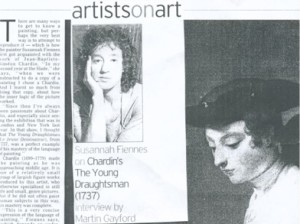Susannah Fiennes
ARTIST
The Daily Telegraph
16th June 2001
Journalist Martin Gayford
Susannah Fiennes on Chardin’s The Young Draughtsman (1737)
There are many ways to get to know a painting, but perhaps the very best way is to attempt to reproduce it – which is how the painter Susannah Fiennes first got acquainted with the work of Jean-Baptiste-Simeon Chardin. “In my second year at the Slade,” she says, When we were instructed to do a copy of a painting I chose a Chardin. And I learnt so much from doing that copy, about how the inner logic of the picture worked.”Since then I’ve always been passionate about Chardin, and especially since seeing the exhibition that was in London and New York last year. In that show, I thought that The Young Draughtsman (Le Jeune Dessinateur) from 1737, was a perfect example of his mastery of the language of painting.”

Chardin (1699-1779) made the painting as he was approaching middle age. It is one of a relatively small group of largish figure works produced by this artist, who otherwise specialised in still life and small, genre pictures. But if he did not often paint human subjects in this way, his mastery was complete.
“This is a very concise expression of the language of painting,” Fiennes says, “which depends on understanding the relations between opposites. One thing I love is the way that Chardin organises the rectangle of the canvas. The painting is clearly divided into three. The table that the boy is leaning on occupies the bottom third of the picture, then his torso occupies the middle third. So it’s beautifully phrased, like a piece of music or three acts of a play.”
Denis Diderot – the first art critic in the modern manner – began his account of the Chardins at the Salo of 1765 thus: “Here you are again, old magician, with your silent arrangements.”
Fiennes shares his enthusiasm: “I love the way the artist constructs the space through that geometry. It’s very deliberately formed. Just as he counteracts the front of the table with the diagonal of the drawing and the portfolio, so he counteracts that diagonal with the line of the boy’s arm. He’s playing all the time with emphasis. The boy’s upper arm is at a right angle to the chalk and his lower arm.
“You could inscribe a square between the line of the chalk and forearm, the front of the jacket and the lower part of the hat, so that the empty background is charged with positive tension that relates to the boy. The drama of the picture comes from the way that tilted square works within the rectangle.”
Such disciplined geometric division of the picture was a passion of the late Euan Uglow, who taught drawing at the Slade when Fiennes studied there. Since then, as a watercolourist, she has accompanied the Prince of Wales on the occasion of the handing over of Hong Kong.
“Chardin’s work is so considered,” she says. “There are no accidents. I think that’s what I love about it – the way the elements of the picture are impeccably organised. He constructs an illusion of volume, space and light on a flat surface through a concise arrangement of coloured shapes. Just as in the music of Bach you get the feeling that every little note is placed with absolute deliberation and precision, so is everything in this painting done with a particular purpose in mind.”
Chardin did not paint quickly. The Queen of Sweden grew impatient waiting for her commissions. “I have made a habit of not relinquishing my paintings until, to my eyes, they leave nothing to be desired,” he wrote to her.
The economy of The Young Draughtsman is just mind-blowing,” Fiennes says. “Take the tip of the boy’s hat, that little droopy bit, then look at the way Chardin continues that dark shape back all the way through the hat, the hair, into the ribbon, all the way down through the ponytail, and the shadow on the back. It’s all one shape. That dark shape carries on all the way down to the bottom of the picture – even across the bottom horizontal of the table. So instead of illustrating a hat, or hair, Chardin is seeing the mystery of how one shape becomes another shape in a very abstract way.
“Another shape to focus on is the fragment of turquoise under his collar that must be his shirt coming through. It defines the curve of his front so that you don’t read him as a flat shape, you read him as a volume. That tiny bit of floating light and air between the boy’s neck and his hair is so articulate: it defines the back of his neck.
“Just as we’ve had opposites in geometry we also have opposites in colour, The hot red of the boy’s cheek is counteracted by the cold blue-green of the drawing paper. And the red of the ribbon echoes the cheek. The most divine thing is the way that the background colour is a most mysterious, elusive grey that hovers between the greenness and the redness. It’s what you would get if you mixed those two other colours.
“In this picture, the subject serves as a sort of homage to drawing. That sums up what we were striving to do at the Slade. It was almost like a monastic order in the way that we approached our investigation of the subject.”
